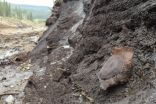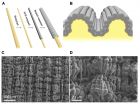(Press-News.org) NEW YORK, NY (July 23, 2015)--Researchers at Columbia University Medical Center (CUMC) have developed a computer algorithm that is helping scientists see how drugs produce pharmacological effects inside the body. The study, published in the journal Cell, could help researchers create drugs that are more efficient and less prone to side effects, suggest ways to regulate a drug's activity, and identify novel therapeutic uses for new and existing compounds.
"For the first time we can perform a genome-wide search to identify the entire set of proteins that play a role in a drug's activity," says study co-author Dr. Andrea Califano, the Clyde and Helen Wu Professor of Chemical Systems Biology and chair of the department of Systems Biology at CUMC.
Scientists design drugs to pinpoint molecular targets in the cell. However, when a drug enters the human body, it becomes part of an incredibly complex system, and can interact with other molecules in ways that are hard to predict. This unanticipated cross-talk causes side effects and stops many promising drug candidates from being used in clinical care. Unfortunately, current experimental methods don't allow scientists to identify the full repertoire of proteins that are affected by a drug.
Members of Dr. Califano's lab have devised a new approach called DeMAND.
(Detecting Mechanism of Action by Network Dysregulation) to characterize a drug's effects more precisely. The method involves creating a computational model of the network of protein interactions that occur in a diseased cell. Experiments are then performed to track gene expression changes in diseased cells as they are exposed to a drug of interest. The DeMAND algorithm combines data from the model with data from the experiments to identify the complement of proteins most affected by the drug.
DeMAND improves on more labor intensive and less efficient methods, which are only capable of identifying targets to which a compound binds most strongly. This provides a more comprehensive picture, because DeMAND identifies many molecules that are affected in addition to the drug's direct target.
So far, DeMAND's predictions are proving to be accurate when tested with follow-up experiments. The researchers report that when they exposed human diffuse B-cell lymphoma cells to a panel of drugs, the algorithm identified 70% of previously documented targets. "The accuracy of the method has been the most surprising result," says Dr. Califano.
The algorithm makes it possible to identify a variety of compounds that cause similar pharmacological outcomes. Using DeMAND, the researchers showed that a similar subset of proteins is affected by the unrelated drugs sulfasalazine and altretamine. Altretamine is currently used to treat ovarian cancer, but these results suggest that, like sulfasalazine, it could be used for bowel inflammation or rheumatoid arthritis too.
Co-senior author Mukesh Bansal sees great potential in this approach, saying, "DeMAND could accelerate the drug discovery process and reduce the cost of drug development by unraveling how new compounds work in the body. Our findings on altretamine also show that it can determine novel therapeutic applications for existing FDA-approved drugs."
INFORMATION:
The Cell paper is titled, "Elucidating Compound Mechanism of Action by Network Perturbation Analysis." The list of authors is: Andrea Califano, Jung Hoon Woo, Yishai Shimoni, Wan Seok Yang, Prem Subramaniam, Archana Iyer, Paola Nicoletti, María Rodríguez Martínez, Gonzalo López, Ronald Realubit, Charles Karan, Brent R. Stockwell, Mukesh Bansal (all at CUMC), and Michela Mattioli, (Fondazione Istituto Italiano di Tecnologia).
This work was supported by grants from the National Institutes of Health (5U01CA168426, 1U01CA164184-02, 3U01HL111566-02, 5U54CA121852-08, 5R01CA097061, R01CA161061), New York Stem Cell Science (C026715) and the Howard Hughes Medical Institute.
The authors declare no financial or other conflicts of interest.
Columbia University Medical Center provides international leadership in basic, preclinical, and clinical research; medical and health sciences education; and patient care. The medical center trains future leaders and includes the dedicated work of many physicians, scientists, public health professionals, dentists, and nurses at the College of Physicians and Surgeons, the Mailman School of Public Health, the College of Dental Medicine, the School of Nursing, the biomedical departments of the Graduate School of Arts and Sciences, and allied research centers and institutions. Columbia University Medical Center is home to the largest medical research enterprise in New York City and State and one of the largest faculty medical practices in the Northeast. For more information, visit cumc.columbia.edu or columbiadoctors.org.
SPOKANE, Wash. - Pharmaceutical sciences researchers at Washington State University have discovered a protein's previously unknown role in cell division.
The well known protein ATF5, or Activating Transcription Factor 5, controls how often specific genes are expressed, or copied from DNA. ATF5 regulates genes that control cell survival.
But the research team has identified a part this protein is playing that is not related to its transcription factor role. Within the part of the cell called the centrosome, ATF5 is also acting as a structural protein.
Structural ...
Knee pain in older adults, often caused by osteoarthritis, usually means more visits to the doctor and also can be a harbinger of disability.
A study led by Daniel White, assistant professor of physical therapy at the University of Delaware, found that an intensive regimen of regular exercise and a healthy diet might reduce the short-term onset of knee pain for overweight adults with Type 2 diabetes mellitus.
Published in Arthritis Care and Research, White's article "Can an Intensive Diet and Exercise Program Prevent Knee Pain Among Overweight Adults at High Risk'' ...
New research has revealed abrupt warming, that closely resembles the rapid man-made warming occurring today, has repeatedly played a key role in mass extinction events of large animals, the megafauna, in Earth's past.
Using advances in analysing ancient DNA, radiocarbon dating and other geologic records an international team led by researchers from the University of Adelaide and the University of New South Wales (Australia) have revealed that short, rapid warming events, known as interstadials, recorded during the last ice age or Pleistocene (60,000-12,000 years ago) ...
A multi-institutional team of researchers has identified an apparently successful treatment for a genetic immune disorder that causes a multitude of health problems - ranging from infections, diabetes, lung disease and the body's immune system attacking and damaging healthy tissues.
Led by Cincinnati Children's Hospital Medical Center and the National Institute of Allergy and Infectious Diseases (NIAID), the researchers report in the July 24 edition of Science a promising therapy for a disorder called LRBA deficiency. They tested the drug abatacept - already FDA-approved ...
This news release is available in Japanese.
The discovery of a four-legged fossil of a snake hints that this suborder may have evolved from burrowing, rather than marine, ancestors. The unique four-legged specimen, found in Brazil's Crato Formation, provides us with more insight into how these creatures transitioned into the sleek, slithering reptiles that we are familiar with - and often fearful of - today. By analyzing both the genetics and the morphological features of this species compared to other known snake species, and giving different weight to ...
This news release is available in Japanese.
In the race to produce highly stretchable conductors, researchers have developed a new technique that aligns sheets of layered carbon nanotubes along stretched rubber cores, creating an extremely flexible conductive fiber. From pacemaker leads to flexible displays and batteries, there is a growing need for fibers that don't lose their conductivity upon repeated stretching, twisting or flexing. The challenge has been to create a conductive material that is highly elastic, but that maintains a high level of ...
Scientists have identified a critical function of what they believe to be schizophrenia's "Rosetta Stone" gene that could hold the key to decoding the function of all genes involved in the disease.
The breakthrough has revealed a vulnerable period in the early stages of the brain's development that researchers hope can be targeted for future efforts in reversing schizophrenia.
In a paper published today in the journal Science, neuroscientists from Cardiff University describe having uncovered the previously unknown influence of a gene in ensuring healthy brain development.
The ...
COLLEGE PARK, Md. - Do you have gender "faultlines" in your organization? New research suggests that such fissures appear when gender differences solidify into cliques. And this tends to occur when members of one gender share other demographic traits and professional interests, such as age, job responsibilities and time served. For example, the men in one organization might be young techies, while the women might tend to be middle-aged marketers. Or vice versa. What's important is that several qualities align in addition to gender, creating a stronger sense of in-group ...
ANN ARBOR--A new University of Michigan study finds that teens using marijuana for medical reasons are 10 times more likely to say they are hooked on marijuana than youth who get marijuana illegally.
The study is the first to report on a nationally representative sample of 4,394 high school seniors and their legal or illegal medical marijuana use as it relates to other drug use. In the study, 48 teens had medical marijuana cards, but 266 teens used medical marijuana without a card.
Carol Boyd, the study's lead author and professor at the U-M School of Nursing, said ...
MADISON, Wis. -- University of Wisconsin-Madison engineers have developed a new approach to structuring the catalysts used in essential reactions in the chemical and energy fields. The advance offers a pathway for industries to wean themselves off of platinum, one of the scarcest metals in the earth's crust.
In an effort to reduce the catalysis world's dependence on this highly reactive and versatile -- but also quite expensive -- metal, UW-Madison chemical engineering Professor Manos Mavrikakis and his collaborators have turned to the nanoscale structure of particles, ...



